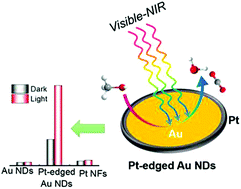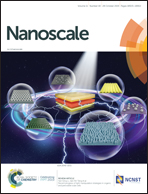Plasmonic hot electron transfer in anisotropic Pt–Au nanodisks boosts electrochemical reactions in the visible-NIR region†
Abstract
Anisotropic plasmonic metals have attracted significant attention in enhancing the catalytic performance of catalysts due to their broad light-harnessing capabilities and active hot electrons; however, limited investigations have been dedicated towards improving their electrochemical reaction performance in the visible and near infrared (NIR) regions. Herein, anisotropic Pt-edged Au nanodisks (NDs) were synthesized by controlling the preferential loading of Pt and used as catalysts for plasmon-enhanced electrochemical methanol oxidation reactions (MORs) under visible-NIR light irradiation by, and the light-enhanced electric current over the Pt-edged Au NDs was found to be 3-fold higher than that under dark conditions. Wavelength-dependent electric current over the Pt-edged Au NDs for the MOR in the visible-NIR light region demonstrates that the light-induced enhancement of the electric current is due to surface plasmon resonance (SPR) of the Au NDs. Furthermore, plasmonic hot electron transfer was studied by the single-particle photoluminescence images and spectra of Au NDs and Pt–Au NDs, and the dipole surface plasmon resonance (DSPR) mode was proved to be the main channel for hot electron transfer. During the electrochemical reaction under visible-NIR light irradiation, a plasmonic hot electron is transferred to the electrode, and a “hot hole” is left on the surface, boosting the MOR.



 Please wait while we load your content...
Please wait while we load your content...